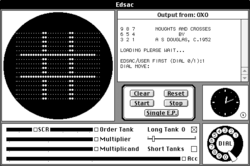OXO
| OXO | |
|---|---|
 OXO played in an EDSAC simulator for the Classic Mac OS | |
| Developer(s) | A S Douglas |
| Platform(s) | EDSAC |
| Release date(s) |
|
| Genre(s) | Puzzle |
| Mode(s) | Single-player |
OXO or Noughts and Crosses is a video game developed by A S Douglas in 1952 for the Electronic Delay Storage Automatic Calculator (EDSAC) computer, which simulates a game of noughts and crosses, also called tic-tac-toe. It was one of the first games developed in the early history of video games. Douglas programmed the game as part of a thesis on human-computer interaction for the University of Cambridge. The EDSAC was one of the first stored-program computers, with memory that could be read from or written to, and had three small cathode ray tube screens to display the state of the memory; Douglas re-purposed one screen to demonstrate portraying other information to the user, such as the state of a noughts and crosses game. After the game served its purpose, it was discarded on the original hardware but later successfully reconstructed. OXO, along with a draughts game by Christopher Strachey completed around the same time, is one of the earliest known games to display visuals on an electronic screen. Under some definitions it thus may qualify as the first video game, though other definitions exclude it due to its lack of moving or real-time updating graphics.
History
.jpg)
The Electronic Delay Storage Automatic Calculator (EDSAC) mainframe computer was built in the University of Cambridge's Mathematical Laboratory between 1946 and 6 May 1949, when it ran its first program,[1][2] and remained in use until 11 July 1958.[3] The EDSAC was one of the first stored-program computers, with memory that could be read from or written to, and filled an entire room; it included three 35×16 dot matrix cathode ray tubes (CRTs) to graphically display the state of the computer's memory.[4][5] As a part of a thesis on human-computer interaction, Alexander S. Douglas, a doctoral candidate in mathematics at the university, used one of these screens to portray other information to the user; he chose to do so via displaying the current state of a game.[6][7]
Douglas used the EDSAC to simulate a game of noughts and crosses, also called tic-tac-toe, and display the state of the game on the screen. Like other early video games, after serving Douglas's purpose, the game was discarded.[4] Douglas did not give the game a name beyond "noughts and crosses"; the name OXO first appeared as the name of the simulation file created by computer historian Martin Campbell-Kelly while creating a simulation of the EDSAC several decades later.[8] Around the same time that OXO was completed, Christopher Strachey expanded a draughts program he had originally written in 1951 and ported it to the Ferranti Mark 1, which showed the state of the game on a CRT display.[9][10] OXO and Strachey's draughts program are the earliest known games to display visuals on an electronic screen, though it is unclear which of the two games was displayed first.[7] As it ran on a computing device and used a graphical display, OXO is considered under some definitions to be a contender for the first video game,[11] though under others it does not due to its lack of moving graphics or graphics which update continuously.[12]
Interaction
Each game was played by one user against an artificially intelligent opponent, which could play a "perfect" game. The player entered their input using a rotary telephone controller, selecting which of the nine squares on the board they wished to move next. Their move would appear on the screen, and then the computer's move would follow; the game display only updated when the game state changed.[8] OXO was not available to the general public and could only be played in the University of Cambridge's Mathematical Laboratory by special permission, as the EDSAC could not be moved, and both the computer and the game were only intended for academic research purposes.[13]
References
- ↑ Wilkes, M.V. (January 1997). "Arithmetic on the EDSAC". IEEE Annals of the History of Computing. IEEE. 19 (1): 13–15. ISSN 1058-6180.
- ↑ "Pioneer computer to be rebuilt". Cam. University of Cambridge. 62: 5. 2011.
- ↑ "EDSAC 99: 15–16 April 1999" (PDF). University of Cambridge Computer Laboratory. 1999-05-06. pp. 68–69. Retrieved 2013-06-29.
- 1 2 Donovan, Tristan (2010-04-20). Replay: The History of Video Games. Yellow Ant. pp. 1–9. ISBN 978-0-9565072-0-4.
- ↑ Campbell-Kelly, Martin (2001). "A Tutorial Guide to the EDSAC Simulator" (PDF). University of Warwick. Archived (PDF) from the original on 2015-12-22. Retrieved 2015-12-18.
- ↑ Kurosu, Masaaki, ed. (2014-06-09). Human-Computer Interaction Applications and Services: 16th International Conference, HCI International 2014, Heraklion, Crete, Greece, June 22-27, 2014, Proceedings, Part 3. Springer Publishing. p. 561.
- 1 2 Smith, Alexander (2014-01-22). "The Priesthood At Play: Computer Games in the 1950s". They Create Worlds. Archived from the original on 2015-12-22. Retrieved 2015-12-18.
- 1 2 Hey, Tony; Pápay, Gyuri (2014-11-30). The Computing Universe: A Journey through a Revolution. Cambridge University Press. p. 174. ISBN 978-0-521-15018-7.
- ↑ Bellis, Mary (2013-03-29). "History of Computer Chess and Programmer Dietrich Prinz". About.com. IAC. Retrieved 2013-04-04.
- ↑ Link, David (2012). "Programming ENTER: Christopher Strachey's Draughts Program" (PDF). Resurrection. Computer Conservation Society (60): 23–31.
- ↑ Wolf, Mark J. P. (2012-08-16). Encyclopedia of Video Games: The Culture, Technology, and Art of Gaming. Greenwood Publishing Group. pp. 3–7. ISBN 978-0-313-37936-9.
- ↑ Kowert, Rachel; Quandt, Thorsten (2015-08-27). The Video Game Debate: Unravelling the Physical, Social, and Psychological Effects of Video Games. Routledge. p. 3. ISBN 978-1-138-83163-6.
- ↑ Cohen, D. S. (2014-09-20). "OXO aka Noughts and Crosses - The First Video Game". About.com. IAC. Archived from the original on 2015-12-22. Retrieved 2015-12-18.
